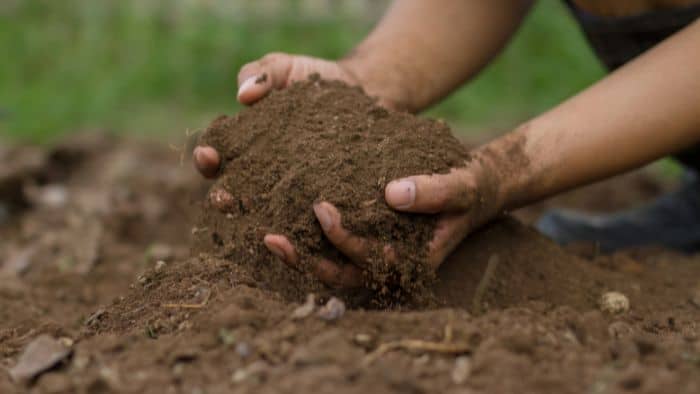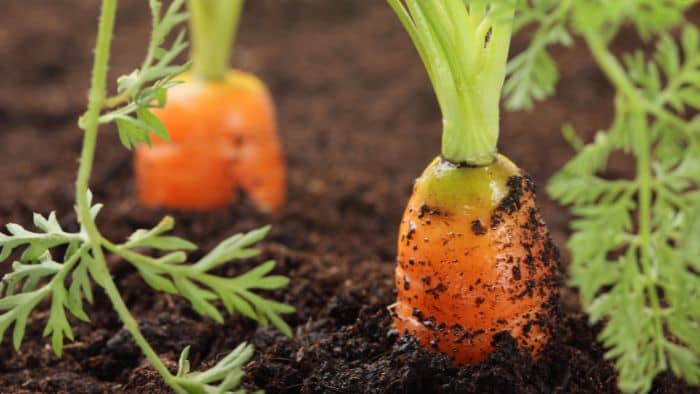What is the best soil for carrots in containers? Carrots are one of my favorite vegetables to grow. A home-grown carrot, eaten within 5 minutes of pulling it out of the ground tastes better than any carrot you will find in the shop. To produce the best-tasting carrots your soil needs to be right so that you produce big carrots and not big carrot tops. The last thing you need is to produce pretty-looking big green pot plants and when you pull the carrots out, you have nothing below the soil line! Read more to find out my personal tips for mixing the best soil for carrots in containers and in general.
One of my favorite plants to grow is a carrot. I grew my first carrots when I was a little boy and I remember anxiously going down to the carrot bed I had planted to see how they were doing each day. Time passes slowly at that age, and the carrots seemed to just not be growing. They were planted in some miserable clay soil, and I planted them so close to each other that I produced a lawn. Eventually, I pinched some of my Moms 3:2:3 lawn fertilizer and sprinkled it on my plants – they grew into giant green bushes, and never produced any carrots at all! Thus began a journey to learn how to grow carrots and learned how to share with you my knowledge on the best soil for carrots in containers.
What Is The Perfect Carrot Soil Mix?

My Tips On Preparing Soil For Carrots
Carrots need well-drained, sandy soil that is not too rich in nitrogen but contains enough potassium and phosphate to encourage root growth. Given that a carrot is a root, root growth is very important when we consider the best soil for carrots in containers. The majority of commercial potting soil probably has more nitrogen in it than is needed to get a good carrot crop hence I will show you a trick to avoid problems here.
I am forced to keep carrots in large pots in my garden – I buy IBC containers and cut them in half. Then I put the halves on the ground and fill them with my custom mix which consists of 1 part coarse river sand, one part fine gravel, and one part aged compost. The remaining part is comprised of half pearlite, a quarter shell grit, and a quarter finely sifted mature manure.
When I say mature manure I mean manure that has stood in a compost heap for a year. This reduces the amount of nitrogen in the manure.
This soil is a light fluffy loam and it develops over the years in the pots to be better and better if you keep feeding it with manure, compost, and shell grit. I personally do not buy shell grit – I just collect sea shells when I go fishing and bring a few pounds back with me. I then crush these with a hammer and place them in a bucket of water for a week to leach the salt out. After this they are ready for inclusion in the soil – you can sprinkle sea shells on nearly any soil and it helps. This is a useful tip for mixing the best soil for carrots in containers.
Perfect carrot soil should never harden or develop a crust on the surface! I can stick my hands into this soil three months after planting carrots and it is still light and fluffy. This is a good test of soil. A carrot needs to be able to easily stretch its roots into the soil and expand sideways with as little pressure from the soil as possible. The best soil for carrots in containers is always soft and friable.
If you cannot find all of the above ingredients, improvise and buy standard potting soil as listed above. Mix that with pearlite, shell grit, gravel (you can always find this on the side of roads and paths if you look in the gutters after rain), and manure.
Ok, so now we have our soil, what next?
Preparing Soil For Carrots
It may look like we just covered that above, but this is not so. To prepare the soil you have mixed so as to get the perfect carrots, place it in your pots and water it. Let the soil condition so that is can settle into itself for a few days. This allows all the microbes in the soil to grow and become active.
Planting carrots into the soil is easy. I would suggest a carrot such as Atomic Red. These are exceptionally tasty and you will get a mix of red and orange carrots from such a pack. If you want orange carrots, Kuroda is a reliable strain that produces excellent-tasting carrots.
I always plant a few radish seeds with my carrot seeds. Cherry belle is an old reliable strain that will be ready to harvest in a few weeks. The radishes help to provide a bit of shade for your emerging radish seedlings. In addition, radishes are heavy feeders and mop up excess nitrogen in the top layers of the soil. This is important because it means that your carrots will stretch their roots down deep, find potassium and become big fat carrots, with small green tops. You want to grow carrots, not carrot plants! A slightly nitrogen-depleted soil produces better-tasting carrots in my opinion.
The planting of the radishes as a cover crop is in my opinion the single most important part of preparing the soil for carrots! It always just makes the carrots better. You get a lovely crop of radishes – cherry bell can be eaten on the hoof as you garden – just rinse it and eat the whole thing, leaves and all! You will feel super healthy from that. So remember when preparing the best soil for carrots in containers, that you need to grow radishes with your carrots to potentiate this soil.
What Is The Best Soil For Carrots In Raised Beds?
The soil listed above is perfect. If you are making soil using some of the soil in your own garden, you can add a lot of compost and a little bit of old composted manure. Adding pearlite is always a good idea, and adding some shell grit and gypsum helps to improve the soil.
A raised bed is essentially a big pot or container, hence following the suggestions for a container soil listed in the previous section is the best option. The best soil for carrots in containers is also the best soil mix for carrots in raised beds!
How To Make Sandy Soil For Carrots
An alternative to mixing my preferred best soil mix for carrots detailed in previous sections is just to use a sandy soil mix. In this case, you can skip the pearlite as sandy soils tend to be quite well aerated. I have had quite exceptional success with sandy river soil, and into this, I mix about a third by volume of finely sieved compost and I added a bit of vermiculite. Vermiculite helps to retain water – in sandy soil you can end up with water draining away very fast – hence to prepare a sandy soil that is an alternative to my best soil mix for carrots, you need to improve water retention with vermiculite.
Sandy soil can produce exceptional carrots. These soils can be a bit nutrient-poor, and with time you will learn how to regulate this. I normally add a little bit of wood ash from my barbecue towards the end of the first month of growth. This provides Potassium for better root formation and is an important thing to remember when mixing sandy soil that is an alternative to the best soil for carrots in containers that I detailed above.
A Summary Of Carrot Soil Requirements And How To Make The Best Carrot Soil Mix
When preparing the best soil for carrots in containers bear the following in mind. Carrots require well-drained soil, with a pH between 6 and 7. They require a supply of nutrients, with not too much nitrogen. In this regard, any soil that you mix should contain some sieved compost, a little manure, and something to improve soil texture so that the soil is soft and not compacted – you want the roots to be able to expand easily.
If you follow the above suggestions you will be able to formulate the best soil for carrots in containers. Do not stress too much – carrots are pretty forgiving, and you will get a crop in nearly any soil – but as you perfect your own grow methods you will find that the carrots you produce are sweeter, firmer, and more abundant.







